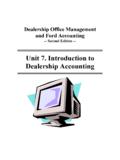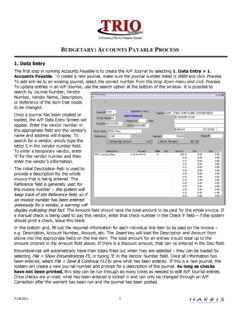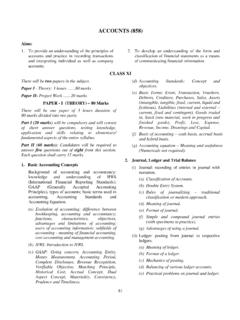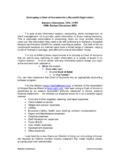Transcription of Accounting Policies and Procedures for Early Stage …
1 Accounting Policies and Procedures for Early Stage CompaniesTable of ContentsIntroduction ..1 Internal controls for component ledger .. purchasing cycle .. revenue cycle .. assets .. benefits ..25 Insurance ..25 Sales tax ..25 Accounting periods ..25 Appendix 1 1999 PricewaterhouseCoopers LLP. PricewaterhouseCoopers refers to the firm of PricewaterhouseCoopers LLP and other members of the worldwide PricewaterhouseCoopers LLPINTRODUCTIONThis manual is produced for use by managementof companies in the Early stages of provides basic Accounting Procedures andcontrols which should be implemented in orderto lay a foundation for a system of internalaccounting controls.
2 Also provided in thismanual, are examples of the key documentationmaterials which will be required in order toachieve internal controls. This manual is intended to be used only as anaid and should not be considered a replacementfor management involvement and effort indeveloping a secure internal manual is designed to address the needs ofearly Stage companies with relatively simpleaccounting systems and transactions. As acompany grows, it will need expanded internalcontrols which transcend the scope of thisdocument. Management must, therefore, becontinuously aware of the growing control needsof the company and update the controlenvironment as necessary.
3 When it becomesnecessary to go beyond the scope of this manual,contact PricewaterhouseCoopers LLP(PricewaterhouseCoopers) in order to ensure thatall controls needed are properly GENERAL LEDGERThe General Ledger (G/L) accumulates allaccounting activity for an Accounting importance of the G/L system becomesapparent in light of a twofold objective transactions are properly accumulated,classified, summarized and recorded in theaccounts and 2. Financial transactions and reports accurate-ly reflect the details of all evidenced by the objective, the activities of aG/L system are varied, ranging from thepreparation of journal entries (JEs) to theproduction of the final financial statements.
4 Thebasic flow of events for a G/L system is simple,revolving mainly around the journal , JEs are prepared by summarizing theperiod s activity. JEs are then posted to the are generated from the G/L, reviewed foraccuracy and any variances are , financial statements are produced fromthe final general ledger. Because of the impact ofthe G/L system, the following key controls areimperative:qApproval of all JEs by a designated officerbefore of the various sub-ledgers(such as accounts receivable, fixed assets,accounts payable, etc.) to the G/L on a timelybasis and investigation and correction of anydiscrepancies. See Appendix A for a samplesubsidiary ledger of month-end financial statements byofficers and managers, including promptexplanation of any variances or stated above, summarization of the month sactivities is done via the journal entry.
5 The differentaccounting activities which give rise to journalentries are as activities qCash receipts summarized bytotaling the cash receipts journal(See Cash section).qCash disbursements summarizedthrough a recap of the cash dis-bursements log (See Cash section).Note that automatic deductionsfrom the bank account for insur-ance, payroll, etc. should be indi-vidually recorded upon activitiesqAccounts payable summarized viathe accounts payable and cash dis-bursements subsidiary ledgers (SeeCash & Purchasing Cycle sections).qAccounts Receivable summarizedthrough a recap of the sales journaland the cash receipts journal (SeeCash & Revenue Cycle sections).
6 QPayroll summarized through pay-roll reports generated by the outsidepayroll service (See Payroll section).qDepreciation/Amortization sum-marized through the fixed asset log (see Fixed Assets section).qAmortization of prepaid expensesand other assets (see Other section)should be done by maintaining asupporting schedule for each prepaid schedule should life of each monthly amortizationPrepare the JE by summarizing all monthly amortization. A typical JE to amortize the current asset prepaid insurance follows:DebitInsurance expensexxCredit Prepaid insurancexxThe above entry retires (expenses) the portion ofthe asset which was used up in the period onwhich you are additional JEs must be backed up bysupporting posting the approved JEs to the G/L, certainreports should be produced.
7 It is important thatprinted reports and supporting documents necessary to provide an audit trail are retained,as these will be useful in researching problemsand supporting an examination by following reports are usually generated. qTrial Balance Lists all G/L accounts with ending Statements Balance Sheet & Income Statement2 Accounting Policies and Procedures for Early Stage Companies3 PricewaterhouseCoopers LLPF inancial statements should be distributed to all officers and managers who have control overcosts and have the ability to make financialdecisions. The statements should be reviewedand discussed monthly and unusual items identified and of AccountsThe chart of accounts is the foundation of theaccounting system.
8 It lists all of the individualaccounts (assets, liabilities, stockholders equity,revenue and expense) of the company. Its lengthdepends on the requirements of managementand the nature of the company s operations. An example chart of accounts is shown inAppendix CASHA. Cash ReceiptsAdequate control over cash receipts is individual outside the Accounting function,such as a receptionist, should be designated toopen the mail every day. Checks received shouldimmediately be restrictively endorsed andentered on a daily cash receipts log (prepared induplicate). See Appendix I for a sample cashreceipts log. Checks remitted without stubs orbackup information should be photocopied andattached to the Accounting copy of the cashreceipts copy of the daily cash receipts log and thecheck stubs and/or backup information should besent to Accounting .
9 One individual inaccounting should be responsible for recordingthe cash receipt by allocating the funds to theappropriate customer account and creating thecash receipts entry. This is most effectively done through the use of acash receipts journal with specialized columnsfor routine transactions. See a sample cashreceipts journal in second copy of the daily cash receipts logand the endorsed checks should be forwarded toa responsible individual in the accountingdepartment who is not responsible for processingcash receipts. The person should complete thebank deposit slip and verify the completenessand accuracy of the deposit by agreeing the totalto be deposited to the total per the daily cashreceipts log.
10 A duplicate deposit slip, stampedreceived by the bank, should be returned andattached to the Accounting copy of the daily cashreceipts should be made on a daily basis. Cash(except petty cash) should not be kept on thepremises overnight. As your product or servicebegins to generate revenues you should consider the possibility of a lock box arrangement withyour bank. Adopting a lock box arrangementwill eliminate the administrative task of recordingreceipts, reduce the potential misapplication ofcash by employees, and afford better Cash DisbursementsThe control of cash disbursements should be ofsupreme concern to you. Cash is a liquid assetthat can be easily misappropriated.







